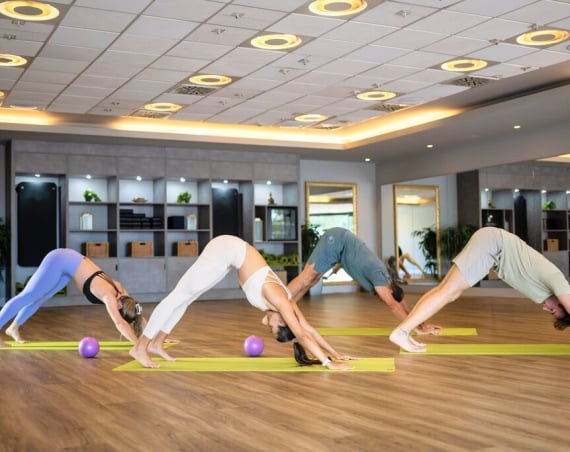If you suffer from lower back pain, you may think that practising yoga is either a bad idea or simply beyond your abilities. In reality, yoga can be a great way to improve your posture, strengthen your back and relieve the many unwelcome symptoms of back pain.
To get the full story, we sat down with Lisa Crossan, SPIRIT Master Trainer and Group Exercise Coordinator at David Lloyd Glasgow Rouken Glen. A fitness instructor who loved high-energy classes, she began suffering from lower back pain to the extent that it affected her job and mental health — until she got into yoga.
What causes lower back pain?
Lower back pain is the leading cause of disability in the UK, and approximately 1 in 6 adults in England have some form of back pain. But what, exactly, causes it? “It’s not just about injuries,” says Lisa. “You can also get lower back pain from sitting all day; it can give you a weak core, poor posture, and short hip muscles. Yoga will help strengthen and stretch back muscles that make you tight.”
Most acute back pain is mechanical in nature, which means the various components of the back have been disrupted in some way. Causes can be congenital, degenerative, lifestyle-based or related to injuries, with risk factors including:
- Age: You’re most likely to first experience lower back pain between the ages of 30 and 50, and it may become more severe with advancing age. The intervertebral discs, for example, begin to lose fluid and flexibility with age, resulting in a loss of cushioning.
- Fitness: If you go all out and exercise a lot after being inactive all week, you’re more likely to suffer painful back injuries than people who make moderate physical activity a daily habit.
- Weight: Being overweight or quickly gaining a lot of weight can put stress on the back and lead to lower back pain.
- Occupation: If your job involves heavy lifting, pushing or pulling, it can lead to injury and back pain. Similarly, working at a desk all day can contribute to pain, especially from poor posture or sitting in a chair with insufficient back support.
- Mental health: Did you know that stress and depression can influence how you perceive your pain and its severity? Anxiety can affect the body in numerous ways, including causing muscle tension.
Is it okay to do yoga with lower back pain?
The short answer is yes! Yoga is a gentle, low-impact activity that is ideal for improving and maintaining back strength and flexibility — though you may need to consult your doctor first if you have long-term pain or an injury. According to Lisa, “People who’ve never done yoga before are surprised at how much it strengthens you; you can feel instant improvements in terms of mindset. The healing powers of yoga are so transformative… The less flexible people feel, the more benefits they’ll get from yoga!”

Remember, though, that it may be better to start with in-person classes rather than self-led sessions: “We’re here to help people. If you suffer from lower back pain [or want to prevent it from happening in the first place], I want you in my class! Be mindful to speak to your instructor about your pain. Go to the class a bit earlier… You can also look at poses online first to get an idea of the basic postures, such as on the David Lloyd Clubs app.”
How does yoga help in some cases of lower back pain?
If you’re dealing with lower back pain, think of yoga as a mind-body therapy that not only treats the physical symptoms but also the stress that accompanies them. Even if it’s just for a few minutes a day, practising yoga will give you more awareness of your body and teach you where you’re holding tension.
Focusing on your balance and steadiness encourages your body to remedy the causes of back pain, such as weak abdominal and pelvic muscles, as well as a lack of flexibility in the hips. When you strengthen these muscles, you improve your posture, reduce the load on your back and — most noticeably — mitigate your aches.
That said, you may still want to set yourself some ground rules to minimise the risk of injury:
“If you’re in a class, don’t feel you have to keep up, you can always take a break, and don’t drop into poses really quickly. It’s about following proper form, listening to the teacher, slowly strengthening and stretching, taking it steady… When you come to a yoga class, just do it to your ability. Never stretch into a position of ‘bad pain’. Ease back if you have a sharp pain or numbness. Pain is a warning. There is ‘good pain’, but you need to practise and gain experience to understand that.”
Lisa Crossan
And how long will it take to feel a difference? “It really depends on the level of pain, what it’s caused by, where it’s coming from,” says Lisa. “Some people get instant relief from certain postures. Lower back pain can be made worse by anxiety. Your muscles tense because you’re worried about your lower back, and that makes the pain worse! When you’re doing yoga, it takes you into the moment. Certain poses can release tension, and that can help instantly. Try to do 2-3 classes per week.”
Can you start yoga at any age?
Absolutely, any age at all! Lisa has a 75-year-old husband and wife who come to one of her classes, as well as people in their 30s who want to improve their balance. Yoga keeps you flexible, builds strength through low-impact exercise and is suitable for all ages and abilities with just a few simple adjustments, such as chair yoga.
Ready to regain strength, improve your flexibility and ease your stress? Find out more about yoga classes at David Lloyd Clubs.
Find a club



